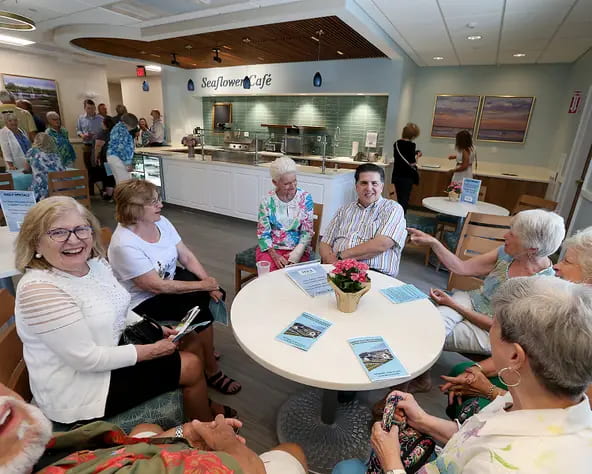“The center has built a reputation of being the people who local communities turn to when they have questions about their aging population.”
Caitlin Coyle, PhD, director
Center for Social and Demographic Research on Aging, UMass Boston
In 1998, when Carol Hamilton began her job as director of the Council on Aging for Marshfield, Massachusetts, the senior center was just one room in the town’s library. In May 2022, Hamilton welcomed members and visitors to a newly expanded, two-story facility including a cafe, new exercise rooms, and many new programs to meet the diverse needs of Marshfield’s fast-growing older population.
“We could never have done all this without the reports from the center,” Hamilton says of two studies conducted over the last decade by the Gerontology Institute’s Center for Social and Demographic Research on Aging (CSDRA), located at UMass Boston. The studies gathered data on Marshfield’s older population and identified their needs and preferences through surveys, focus groups, and interviews. The data led to a $8 million town allocation for the center’s expansion, funding for increased staffing, better public transportation services, and national accreditation.
“Informal surveys are not the same as a thorough study to give credence to what we were seeing as far as the demographics and feedback,” Hamilton says. The reports helped her Council on Aging and town leaders grow together in their understanding of what older Marshfield residents want and need.
CSDRA has similarly matured since the first Marshfield study, which helped to launch the center. Gerontology Professor Jan Mutchler, PhD, began CSDRA as a way to give gerontology doctoral students experience in applied research—and much-needed funding during their lean doctoral years—while offering a valuable service for communities and organizations. Today, as CSDRA marks its tenth anniversary, it has partnered with aging services leaders to conduct more than 75 community studies, with a steady stream of new inquiries.
“We’ve built a reputation of being the people who local communities turn to when they have questions about their aging population,” says CSDRA Director Caitlin Coyle. “With our needs assessments, we’re empowering senior centers and aging services providers with information so they can be their own advocates.” Municipal contracts have doubled in the last few years, growth that has “all come by word of mouth, which says something about the quality of our work,” she notes.
Coyle has come of age professionally alongside CSDRA’s growth. Mutchler hired Coyle as one of her first doctoral student assistants. After earning her gerontology doctorate in 2014, she served a postdoctoral fellowship in health policy and management at Yale University before returning to UMass Boston as a CSDRA research fellow in 2016. UMass Boston named her the center’s director in August 2022, replacing Mutchler, who was named director of the Gerontology Institute in 2021.
Coyle counts among the center’s successes the fact that one of its original roles, providing paid training opportunities for doctoral students, has only grown. CSDRA now works with eight doctoral assistants and recently expanded to include undergraduate assistant positions. “We’re giving students experience with both applied research and primary data collection, which are important transferrable skills,” Coyle says.
The center’s work is building beyond its initial municipal needs assessments and age friendly recommendations to include a focus on aging equity, social isolation, and advocacy through its Elder Index, a data tool measuring the true cost of aging in every county across the United States.
“We can lift up questions that we encounter in the communities and bring them back to the academe to consider,” Coyle says.
The need to offer equitable access resonates across communities, Mutchler says. “We know that residents can experience inequitable access to services and support based on where they live. We know that within communities, some residents are left out of programs or services offered through their council on aging because of language barriers, or because they don’t feel welcome because of their race, culture, or sexual orientation. So the CSDRA helps communities think about who their facilities and programs are for, and if they are reaching who they are intended to reach.”
CSDRA takes a holistic picture of aging, looking at transportation, housing, financial security, and more within each community. “We also acknowledge that an aging population doesn’t just impact older adults,” Coyle says. Some communities want help with investing their funding and planning a new building; other communities are trying to keep up with their changing population, addressing differing preferences among residents in their 60s and those in their 80s and older. “I don’t see the need going away,” she says of CSDRA’s work. “Everyone needs to make decisions based on data.”


June 17, 2024 at 9:05 pm
I had joined your efforts at the Marshfield Council of Aging by participating in your workshops. I had joined this senior center, at first, as a volunteer. On January 7, 2000, I had been invited to work under the SESEP program, and have been there ever since. After this five-year journey, I have to find employment elsewhere since this state-funded program has ended.
I would like to contact you to speak with you about my experience.
I have a Bachelor of Science Degree in Education, Human Services, and have had wide experience working in human service organizations.
Can we connect at your earliest convience.
Thank you.
June 20, 2024 at 10:28 am
Hi Maggie, someone from CSDRA will respond to your inquiry, thanks.